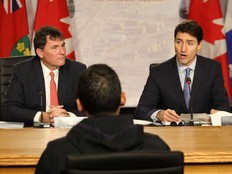Letters: Ample opportunities for inclusion; pronouns not a teacher's responsibility

Article content
Every child is special
Inclusion is an educational process in which placement procedures for exceptional children are based on the conviction that each child should be educated in the most enhanced setting in which their educational and related needs can be satisfactorily addressed.
Inclusion, as a process, supports and encourages the creation of alternatives that will assist educators in serving exceptional children in regular classroom settings with varying degrees of modification of the regular program and with the necessary resources and support.
It is recognized that there may be a small number of children for whom regular class placement with support does not meet their unique needs. Withdrawal from the regular classroom setting for compelling reasons is acceptable and, in these situations, alternatives other than regular classroom placement are considered viable options. It is understood that disruptive or unacceptable behaviour in the classroom or in the school by any child will be reasonably addressed. School districts must ensure that the educational needs of all pupils are being met. Parents of children with exceptional needs understand and accept this requirement as do all parents.
Opportunities for inclusion will continue to be maximized in ways that will enhance the educational experience of all children. In this way, schools are fulfilling a significant role in building supportive communities that value and include people with unique challenges.
Today, the public school system must provide unconditional acceptance of every child – every child is special.
In the 1980s the term integration was used. When it got changed to Inclusion, I’m not sure.
Apparently, we were ahead of our time!
W. Barry Miller
Hanwell
Support students in the classroom
It has been many years since I was an English teacher at Glengarry District High School in Alexandria, Ontario. I taught Grades 9 and 10.
I have been thinking about this lately. During my time, not one student came to me, not one student named Jennifer, say, and asked that from now on I was to call her Jack, and the preferred pronouns were he, his and him. I’ve been wondering how I would have responded if that happened, and here is what I think I would have said in response: ‘Okay, Jack, that’s fine. I will try to remember, and if I forget, you can remind me.’ Then I would get back to doing what I was hired to do, teach English grammar and literature.
On parent/teacher night, when confronted by parents wanting to discuss Jennifer’s performance in English, I would follow their lead and give them a detailed account of ‘her’ performance which was my job to do.
I would not have concerned myself with what, to me, is a family matter between the student and the parents. I would have supported Jack in my classroom in order to get on with my teaching and would not feel any duty to inform the parents of that student’s new gender identification while at school.
Not in my job description. Nor should it be.
Anne Baker
Saint John











Postmedia is committed to maintaining a lively but civil forum for discussion. Please keep comments relevant and respectful. Comments may take up to an hour to appear on the site. You will receive an email if there is a reply to your comment, an update to a thread you follow or if a user you follow comments. Visit our Community Guidelines for more information.